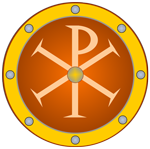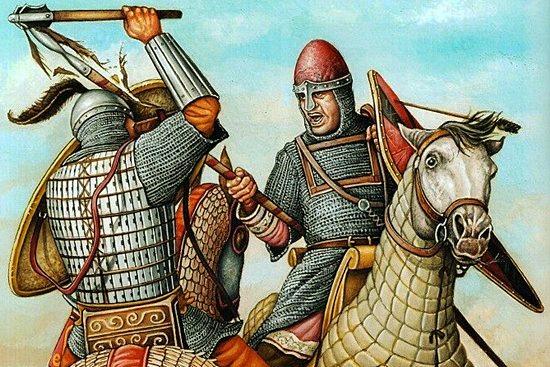
Battle of Zombos bridge |
year: 107411 May 1074 |
| Defeat of a Byzantine army by a rebel force of Norman mercenaries | ★ ★ ★ ★ ★ |
|
enemy: Normans
|
location: At Zombos bridge on Sangarios river (Sakarya), SW of Ankara, not far from Amorium
|
accuracy:
●●●●●
|
|
battle type: Pitched Battle |
war: Military Revolts |
modern country:
Turkey |
| ▼ The Byzantines(emperor: Michael VII Doukas) | ▼ The Enemies | |
| Commander: | Ioannes Doukas | Roussel de Bailleul (Urselios) |
| Forces: | 12.000 | 3.000 horsemen |
| Losses: |
| Background story: |
| In the 11th century, after several centuries in which the military power of Byzantium relied mainly on the thematic army, the use of foreign mercenaries on a large scale began again. There have always been foreign soldiers serving in the Byzantine army, but from the 7th century onwards, foreigners had ceased to be organized into autonomous military corps of foreigners based on nationality. This changed considerably since Basil II, who used the Varangians for the first time. The recruitment of foreign mercenaries escalated in the following decades and peaked around 1050, at a time when Constantine IX Monomachos had to face new external enemies (Seljuks, Pechenegs, Normans) but was also widely challenged at home and had to deal with rebel generals like Maniakis and Tornikios. Among the foreigners in the service of the Byzantine army, the Frankish mercenaries had a prominent position. The majority of these “Franks” were Frenchmen from Normandy who had been in Southern Italy. They had fought on the side of the Byzantines for the first time during the campaign of Georgios Maniakis in Sicily around 1039. Then they turned against the Byzantines there, but this is another story ... Some of these Franks chose to offer their services in the East, and in 1047 they first appeared in Constantinople, being recruited by Constantine IX during the revolt of Tornikios. The Franks were sent later to the eastern frontier and stationed in the border provinces of Asia Minor where problems had begun to arise with various invaders, mainly Seljuk Turks. The presence of the Franks was particularly strong in the thema of Armeniakon and in its capital, Amaseia, where they initially remained for wintering. As the years passed, the presence of the Franks became permanent, and it seems that they were given lands and castles and acquired the status of local rulers, something that obviously happened with the encouragement of the Byzantines who viewed positively the presence of the warlike Franks in this border and strategically important area. The Franks were excellent warriors and a valuable addition to the Byzantine army. The problem was that they remained loyal only if they were well paid, while they became unpredictable when they saw opportunities for profit beyond their typical military duties. Thus, from time to time they caused serious problems as happened with Urselios’ revolt. Roussel de Bailleul (or Ursellus de Ballione) called Rouselios or Urselios (Ουρσέλιος) by Byzantine historians was one of the leaders of the Frankish mercenaries who had the title of vestis. He initially entered the service of Byzantium around 1069, as a member of a mercenary company headed by another Frank, Robert Crispin. Urselios participated in the military campaign of Romanos Diogenes in 1071 which ended in Manzikert, but did not take part in the final battle, as he had been sent to occupy the fortress of Khliat where he was cut off without being able to help the emperor. For many, Urselios' role in that case was questionable. In the chaos after the defeat at Manzikert, the Seljuks and other Turkoman groups intensified their raids in the Byzantine territories of Asia Minor. To deal with the situation, the new emperor Michael VII Doukas decided to send an army to the east, led by Isaac Komnenos (nephew of the old emperor of the same name). Urselios also took part in this expeditionary force with 400 Frankish knights. When the army under Isaac arrived in the region of Caesarea, a serious incident broke out between the Franks and the Byzantines, because Isaac punished a Frank for a disciplinary offense. Because of this, Urselius considered himself offended, and at night he took his men and abandoned the Byzantines. Urselios and his knights headed east and reached Melitini, where with a surprise attack he achieved a small success against the Seljuks. Meanwhile, after his departure, the army under Isaac clashed with the Turks near Caesarea in Cappadocia and suffered a crushing defeat. After his success in the east, Urselios returned to the center of Asia Minor where he indulged in looting, while forcing many cities to pay him a tribute. It was now clear to the Byzantines that they were not simply dealing with an unruly adventurer, but that Urselios was making moves to establish an independent hegemony in Asia Minor. This possibility at that time seemed to be a much more serious threat than the Seljuks. After all, the example of Southern Italy was recent, where a handful of Normans out of nowhere managed to prevail and create a state in Byzantine territory. That is why it was decided to send an army against Urselios. |
The Battle: |
 The army left Constantinople in the spring of 1074. The campaign involved the son of Ioannes Andronikos Doukas (who had also fought in Manzikert as commander of a unit that did not intervene to help the emperor). The veteran general and kouropalatis Nikephoros Botaneiates (later emperor) also participated. In total the imperial army consisted of 12,000 men. 10,000 of them were soldiers of the thematic army and the rest were mercenaries: 1,500 Varangians and 500 Franks. Urselios was in Armeniakon, but when he learned that a Byzantine army was marching against him, he hurried west to confront them. He had with him 3,000 men, most of them knights. The two rival armies met on May 10th on the Sangarios River (modern Sakarya), at the Zombos Bridge, southwest of Ankara, not far from Amorium. Ioannes Doukas, although he had more men, sent envoys to Urselios, proposing that he capitulate and offering amnesty. It seems that the Byzantines had the expectation that Urselios could still be useful to them, while it is very likely, judging by this initiative, that the real target of the campaign was the Seljuks. In any case, Urselios contemptuously rejected the Dukas' proposal. Apparently he had complete confidence in his abilities and in the quality of his men. Doukas was not an experienced soldier and this was evident in this battle. Instead of waiting for the Normans to attack in a position that had a defensive advantage, he chose to cross the river and line up on the opposite bank, with the river on his back. Also, with this move he canceled the option to receive reinforcements from the other regions, something that Urselios was afraid of and it seems that this was the reason why he had rushed to fight the Byzantines. The imperial army lined up on two separate lines, one behind the other. In the right wing of the first line was the corps of the Frankish mercenaries led by a Frank named “Papas”. In the center of the array was Ioannes Doukas with the elite unit of the Varangians (who at that time were probably Anglo-Saxons). Andronikos Doukas was on the left wing. In the back line was Botaneiates with the least experienced divisions. The battle began in the early hours of May 11th. Urselios addressed his compatriots who were on the right side of the Byzantine army and persuaded them to join him. Thus united all the Franks attacked the Byzantine center where Ioannes Doukas and the Varangians were. Despite the Byzantines' surprise at the betrayal of the mercenaries, the battle had not been over yet. But in a repetition of what had happened in Manzikert, the rearguard under Botaniatis did not intervene to help. On the contrary, they retreated inexplicably. After that, it was a matter of time. The Varangians in the center fought bravely, but could not resist the superiority of the Franks which was now numerical too. In the end, they were surrounded and succumbed. Ioannes and his son Andronikos were both wounded and taken prisoners. Immediately after, Urselios reached Chrysopolis opposite Constantinople, aiming to dethrone the emperor. However, Nikiforitzis reacted effectively and, making painful concessions to the Turks, sent them against Urselios. Urselios was forced to retreat to Nicomedia where, in order to gain the support of the locals, he crowned Ioannes Doukas emperor. He then attacked the Turks, but he failed and was eventually taken prisoner along with Ioannes. After a while, his wife paid a ransom and set him free. For a while Urselios lived as a ruler in Amasya. |
Noteworthy: |
| Andronikos Doukas was the great-grandfather of emperor Manuel Komnenos and ancestor of Michael VIII Palaiologos, the first emperor of the Palaiologos dynasty. |
Aftermath: |
| It was another serious Byzantine defeat during the horrible 1070s and another blow to the Byzantine power in Asia Minor. Urselios lived for a while as a prince in Amasya, but was captured by Alexios Komnenos with the help of the Turks. He was released later to help against a revolt, betrayed again, and was executed in 1077. |
|
|
